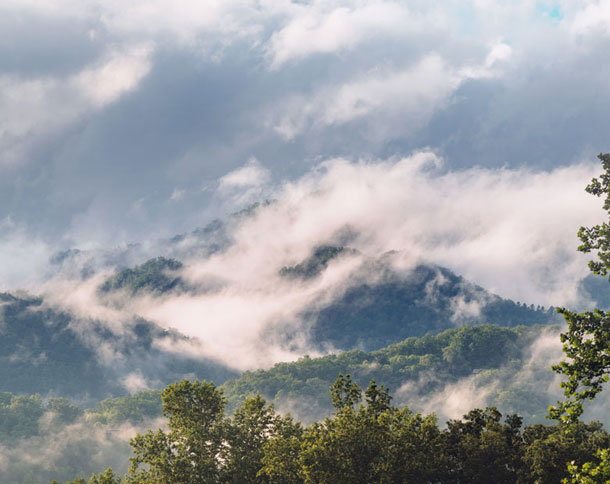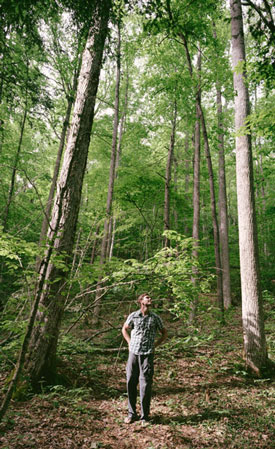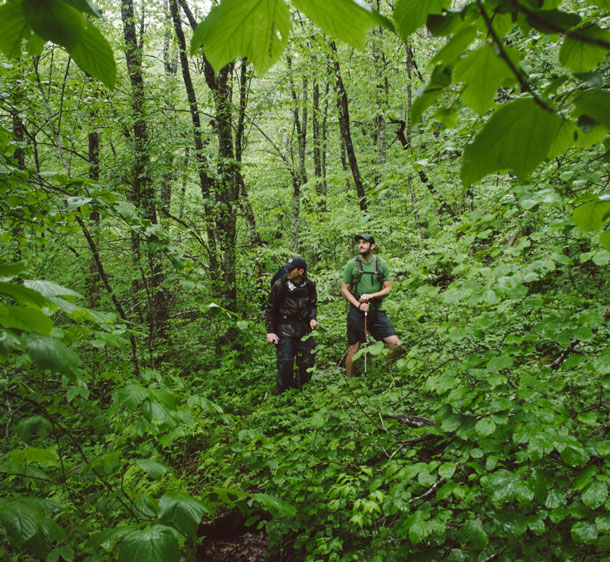Exploring the Parks: Great Smoky Mountains
Air Date: Week of October 18, 2019

The Great Smoky Mountains. (Photo: Andrew Kornylak, Our State Magazine)
The latest in our series on public lands takes us to Great Smoky Mountains National Park, which straddles the mountains of Eastern Tennessee and Western North Carolina. Jeremy Markovich, writer for Our State magazine and host of a podcast called Away Message, shares his segment on finding the most remote spot in the Great Smoky Mountains and chats with Steve Curwood about his time in one of the most biodiverse places in the United States.
Transcript
DOERING: It’s Living on Earth, I’m Jenni Doering.
CURWOOD: And I’m Steve Curwood.
[MUSIC: Sharon Jones & the Dap-Kings, “This Land is Your Land” on Naturally, Daptone Recording Co]]
[SOUND OF BULL ELK CALL]
That’s a bull elk bugling along the Catalochee Creek in Great Smoky Mountains National Park, one of sixty-eight native mammals in what’s considered the most biologically diverse national park in the system. And there are some 200 native birds, including the barred owl with its ghostly call.
[CALL OF BARRED OWL]
CURWOOD: It’s home to 30 species of salamanders, and 14 different frogs and toads, including the bull frog.
[SOUND OF BULL FROG]
But its vast biological diversity doesn’t end there. There are more than 1500 varieties of flowering plants, over a hundred trees and dozens of native fish and reptiles.
In all, science has documented over 19,000 species in Great Smoky Mountains National Park, and last November scientists and the park celebrated the discovery of the one thousandth unique species to be found nowhere else except the Great Smokies. It was a lichen.
Great Smoky Mountains National Park is huge, with more than a half million acres that straddle the mountains of Eastern Tennessee and Western North Carolina. And it has the highest point along the Appalachian Trail, Clingman’s Dome, which is higher than New Hampshire’s Mount Washington. It’s the most popular national park, with more than 11 million visitors each year, nearly twice that of the second most visited, the Grand Canyon. It is also the only major national park that is free. The roads in the park make it accessible, and that’s how most of the millions of visitors enjoy it. But it has a huge backcountry, home to some fifteen hundred bears, and that is where reporter Jeremy Markovich of the North Carolina Magazine, Our State went looking for the most remote spot in his state, defined as the furthest point from a road.
MARKOVICH: This story begins where the road ends.
MAN: Well, now there’s an echo.

The backcountry of Great Smoky Mountains National Park. (Photo: Andrew Kornylak, Our State Magazine)
MARKOVICH: This is the end of what’s called the “Road to Nowhere.” It’s a road through the Great Smoky Mountains National Park that was never finished, and ends on the other side of a tunnel a few miles west of Bryson City.
The trails on the other side will get us very close to the most remote place in North Carolina. In all, it’s a 21-mile hike that’ll take us two days.
[WALKING SOUNDS]
The most remote spot in North Carolina is deep in the backcountry of the Great Smoky Mountains State Park – five and a half miles away from a road. That’s where I find myself hiking with my friend, the photographer Andrew Kornylak, and a local guy we found in Bryson City named Dwayne Parton. A man who had thru-hiked the entire length of the Appalachian Trail, and got the trail name “Jellybean”.
PARTON: Jellybean, yep.
MARKOVICH: Because one time he’d shared his jellybeans with another hiker.
PARTON: And I let him take out of the jar.
MARKOVICH: And that hiker gave him the norovirus.
PARTON: Well, I got the norovirus the next day. [LAUGHS]
MARKOVICH: The first day of hiking was easy. The weather was great. We crossed beautiful mountain streams, saw butterflies and snakes. When we got to the campsite, we sat down and talked with Dwayne, who said he enjoys the outdoors, but came to it very late in life.
PARTON: I needed a reset.
MARKOVICH: Why did you need a reset?
PARTON: Well the truth [is], I went through a really nasty divorce. Everything that you knew about yourself is gone. It’s like you wake up and then someone that you love tells you, ‘Hey I don’t love you.’ Oh my gosh, what just happened? You’re floored. And that’s the start.
MARKOVICH: Three years ago, Dwayne hiked the Appalachian Trail — and he finished on his 30th birthday. Since then, he’s bounced around a bit, to Alaska, Oregon, Montana and then back to North Carolina.
MARKOVICH [TO PARTON]: What did you learn about yourself after doing all that?
PARTON: I don’t know if it’s like anything specific, you just feel more confident in who you are. Like, if singing is your example, maybe my voice is just never meant to sound like someone who can sing really well, and just coming to grips with that. Like, that’s just who I am, and that’s okay. Like, having peace with just being who you are instead of trying to be someone that you’re not is a pretty big part of being alone.
[SOUNDS OF RAIN ON TENT]
MARKOVICH: So it’s almost 9:00 on day two, and that sound is the rain that’s hitting my tent.
So, here’s a fun fact: The Smokies are the wettest part of North Carolina. And so, we set out to find the most remote spot in the state in a downpour.
[HIKING SOUNDS]
MARKOVICH: First, we hiked up to the top of a ridge. Then, at 4,900 feet in elevation, we followed a new trail along the ridgeline for a mile until…
PARTON: If start making our way down the hill there, I think we’ll hit it.
MARKOVICH:… we had to leave the trail behind. And this is why we’d brought Dwayne with us, because he had experience going off-trail. And going off trail is not something you take lightly. Right away, we were surrounded by green in every direction. Dwayne was wearing a green shirt — not the best choice.
MARKOVICH [TO PARTON]: Where’d you go?
MARKOVICH: Plus, it was slippery and I fell.
[MUFFLED SOUNDS]
MARKOVICH: But soon, thanks to the GPS on my phone –
This is it.
-- we found the most remote spot in North Carolina.
KORNYLAK: Who in their right mind would go out here? [LAUGHS] Nobody!
MARKOVICH: It was anti-climactic.
MARKOVICH [TO KORNYLAK]: What do you think about, about this?
KORNYLAK: It’d be cooler if we saw a bear. That would make it cool.

North Carolina’s most remote spot. (Photo: Andrew Kornylak, Our State Magazine)
MARKOVICH: We’d planned on staying here longer — to listen, to look around and to feel what we could feel. But we were wet and tired. And after 15 minutes, we set back out to find the trail. After a long, long hike back, we made it back to our cars -- just before nightfall.
That night, Dwayne, Andrew and I had pizza and beer in Bryson City. By then, the rain had let up and you could see these wispy white clouds hanging among the green mountains. And I remembered what Dwayne had said the day before, about his reason for coming with us.
PARTON: I had kind of forgotten what it was like to be on the trail. So, you come out and set up camp and you’re walking around in the woods and there’s no internet to distract you. It’s kind of like ‘Oh wow, this is kind of nice. Yeah, this feels good. I forgot how good this feels.’
MARKOVICH: Remote isn’t always a place. Sometimes, it’s a state of mind.
CURWOOD: Jeremy Markovich is a reporter for the North Carolina magazine Our State. He's also host of the podcast Away Message. And he joins me now. Thanks, Jeremy. That's a really nice story.
MARKOVICH: Oh, thank you.
CURWOOD: So, what's it look like right now here in the fall, towards the end of October, in the Great Smokies?
MARKOVICH: You know, it's great no matter when you're up there, but this time of year is especially vibrant. And this is the time when the Smokies really get packed with leaf peepers. And it's just... all the colors are amazing. And everywhere you look it's just this amazing palette of color and just... it's great. It's something that you have to take in, I mean, pictures sometimes don't even do it justice. It's just in every direction.
CURWOOD: And you can see these colors in the back country, where you were, finding this most remote place, but right on the roads.
MARKOVICH: Oh yeah, like right off the road. Heading through the park, the color is just everywhere. And this is the interesting thing. I mean, the Great Smoky Mountains National Park is the most visited park in the national park system, but there are different parts of it. So, the parts off the roads are usually packed with people and in the parts that I went to, which is kind of the western edge of the park, there's not as many people. In fact, the place where we left for the hike, you know, we saw a few people in maybe the first mile, and then that was about it. So, the Smokies are usually very busy, but not busy everywhere.
CURWOOD: Right, so, with the folks who maybe don't want to hike, there's beautiful stuff to see and maybe a few more people, but in the back country, you can be by yourself. And the lesson of your story, apparently, is that you have to go away to find oneself. How fair is it to say that?
MARKOVICH: You know, sometimes it's a little bit presumptuous to think that we can go out and find ourselves in a weekend, over a couple of days, over one long hike. I think, when I set out, I just wanted to see what it was like, but I kind of thought it would shake something loose. And it did, but not in the way that I thought. I mean, I thought I would go to this most remote place and feel something that I didn't actually feel. And what I ended up coming out of it was... you know, it really is a state of mind. You really have to think about yourself and what it means to isolate maybe your mind as opposed to isolating your physical presence. So, it took me a trip way out in the Smokies to figure that out. But that is something that I figured out.
CURWOOD: Uh-huh. And what was the benefit?

Jeremy Markovich, writer for Our State magazine and host of a podcast called Away Message. (Photo: Courtesy of Our State)
MARKOVICH: You know, I think it's a matter of sending yourself to somewhere that you don't know what's going to happen. I think sometimes it's very easy, in an age where you can Google anything, you can bring anything up at your fingertips right away, the information is there. I mean, if you want to learn about anything on Earth, it's not hard to at least get a few sentences on it. And when I stood out there, you know, I knew a little bit about what it was going to be like out there. I didn't know exactly what it was gonna be like until I got there. I really didn't have any clue as to what this spot would be like. And when you get there, it's a spot in the woods. It's a little bit underwhelming. But it's something that you do feel a little bit of discovery. You feel like 'I've done something that very few people have.' And so I think it is setting a goal and then trying to achieve that goal and then you get a lot out of it that you didn't even think you were going to get out of it.
CURWOOD: Even if you fall on your tail feathers.
MARKOVICH: Even if you do that.
CURWOOD: [LAUGHS] So, how valuable is the Great Smokies National Park? If I understand this correctly, this is the largest wild space east of the Rockies. It's one of the very few places where you can actually get to a wild space, with everything from bears and elk and many, many stinging mosquitoes.
MARKOVICH: Yeah, it's kind of this green oasis in the mountains. And there are a lot of wild spaces all across that area, but it's as accessible and as useful as you want it to be. I think that's the part, is that you can explore in the Smokies for a very long time and see so many different things. I mean, one of the things about being out there was, one of the nights we camped, I was in my tent and everything kind of lit up as if there was a car out there. As if there were, you know, headlights coming across the tent flap. And I walked out and I was, 'Well, what is this?' And it's the fireflies. And the fireflies were so bright, and the light was just incredible. And, you know, you have to be in the right place at the right time or go out there to experience it for yourself to see those sorts of things. You know, another group of people that we actually met out there, they go out there every year, and they've been doing that for maybe a week at a time every year, for years and years and years, these two guys. And they barely ever see anybody, maybe they’ve seen like a dozen people during that entire time out there. So, they keep on exploring this one huge place. And it allows you to come back and back and back and just see different aspects of the same place. Every time you go out there, it surprises you.
CURWOOD: Isn't it amazing that the fireflies actually blink in synchronicity? That they do it all as a group?
MARKOVICH: Yeah. It's incredible. I mean, I knew that that was a thing. And then I got out there and it happened and I was just like, 'Wait, what?' It like erases your mind because it's just... happens in a way that you do not expect. And so you have to see, oh, this is the thing that you expected and you're still blown away by it.
CURWOOD: Talk to me about an amazing creature or plant that you've seen there.
MARKOVICH: You know, that's the thing. It is so vibrant. It's like it was painted by Disney illustrator. It is lush and green in every direction. You are really in a temperate rainforest, and that's not like an exaggeration. You know, some parts get up to like eight feet of precipitation every year. And so it just causes everything to grow and grow green. And then you can run into a bear out there. You can run into all kinds of stuff out there. Whatever direction you look in, you're going to see some aspect of nature and it goes on in all directions, as far as you can see.
CURWOOD: Amazing. Jeremy Markovich is a reporter for the North Carolina magazine, Our State, and also hosts the podcast Away Message. Jeremy, thanks so much for taking the time with me today.
MARKOVICH: Thank you.
Links
Living on Earth wants to hear from you!
Living on Earth
62 Calef Highway, Suite 212
Lee, NH 03861
Telephone: 617-287-4121
E-mail: comments@loe.org
Newsletter [Click here]
Donate to Living on Earth!
Living on Earth is an independent media program and relies entirely on contributions from listeners and institutions supporting public service. Please donate now to preserve an independent environmental voice.
NewsletterLiving on Earth offers a weekly delivery of the show's rundown to your mailbox. Sign up for our newsletter today!
 Sailors For The Sea: Be the change you want to sea.
Sailors For The Sea: Be the change you want to sea.
 The Grantham Foundation for the Protection of the Environment: Committed to protecting and improving the health of the global environment.
The Grantham Foundation for the Protection of the Environment: Committed to protecting and improving the health of the global environment.
 Contribute to Living on Earth and receive, as our gift to you, an archival print of one of Mark Seth Lender's extraordinary wildlife photographs. Follow the link to see Mark's current collection of photographs.
Contribute to Living on Earth and receive, as our gift to you, an archival print of one of Mark Seth Lender's extraordinary wildlife photographs. Follow the link to see Mark's current collection of photographs.
 Buy a signed copy of Mark Seth Lender's book Smeagull the Seagull & support Living on Earth
Buy a signed copy of Mark Seth Lender's book Smeagull the Seagull & support Living on Earth

